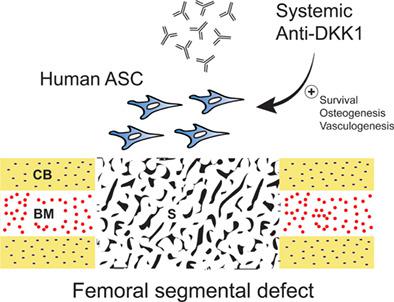当前位置:
X-MOL 学术
›
Stem Cells Transl. Med.
›
论文详情
Our official English website, www.x-mol.net, welcomes your feedback! (Note: you will need to create a separate account there.)
Systemic DKK1 neutralization enhances human adipose‐derived stem cell mediated bone repair
STEM CELLS Translational Medicine ( IF 6 ) Pub Date : 2020-12-30 , DOI: 10.1002/sctm.20-0293 Stefano Negri 1, 2 , Yiyun Wang 1 , Takashi Sono 1 , Qizhi Qin 1 , Ginny Ching-Yun Hsu 1 , Masnsen Cherief 1 , Jiajia Xu 1 , Seungyong Lee 1 , Robert J Tower 3 , Victoria Yu 1 , Abhi Piplani 1 , Carolyn A Meyers 1 , Kristen Broderick 4 , Min Lee 5 , Aaron W James 1
STEM CELLS Translational Medicine ( IF 6 ) Pub Date : 2020-12-30 , DOI: 10.1002/sctm.20-0293 Stefano Negri 1, 2 , Yiyun Wang 1 , Takashi Sono 1 , Qizhi Qin 1 , Ginny Ching-Yun Hsu 1 , Masnsen Cherief 1 , Jiajia Xu 1 , Seungyong Lee 1 , Robert J Tower 3 , Victoria Yu 1 , Abhi Piplani 1 , Carolyn A Meyers 1 , Kristen Broderick 4 , Min Lee 5 , Aaron W James 1
Affiliation

|
Progenitor cells from adipose tissue are able to induce bone repair; however, inconsistent or unreliable efficacy has been reported across preclinical and clinical studies. Soluble inhibitory factors, such as the secreted Wnt signaling antagonists Dickkopf‐1 (DKK1), are expressed to variable degrees in human adipose‐derived stem cells (ASCs), and may represent a targetable “molecular brake” on ASC mediated bone repair. Here, anti‐DKK1 neutralizing antibodies were observed to increase the osteogenic differentiation of human ASCs in vitro, accompanied by increased canonical Wnt signaling. Human ASCs were next engrafted into a femoral segmental bone defect in NOD‐Scid mice, with animals subsequently treated with systemic anti‐DKK1 or isotype control during the repair process. Human ASCs alone induced significant but modest bone repair. However, systemic anti‐DKK1 induced an increase in human ASC engraftment and survival, an increase in vascular ingrowth, and ultimately improved bone repair outcomes. In summary, anti‐DKK1 can be used as a method to augment cell‐mediated bone regeneration, and could be particularly valuable in the contexts of impaired bone healing such as osteoporotic bone repair.
中文翻译:

系统性 DKK1 中和增强人类脂肪干细胞介导的骨修复
来自脂肪组织的祖细胞能够诱导骨修复;然而,临床前和临床研究报告的疗效不一致或不可靠。可溶性抑制因子,例如分泌的 Wnt 信号传导拮抗剂 Dickkopf-1 (DKK1),在人类脂肪干细胞 (ASC) 中不同程度地表达,可能代表 ASC 介导的骨修复的可靶向“分子制动”。在这里,观察到抗 DKK1 中和抗体可增加体外人类 ASC 的成骨分化,同时增加经典 Wnt 信号传导。接下来将人类 ASC 移植到 NODScid 的股骨节段性骨缺损中小鼠,随后在修复过程中用全身性抗 DKK1 或同种型对照治疗动物。人类 ASC 单独诱导显着但适度的骨修复。然而,全身性抗 DKK1 诱导了人类 ASC 植入和存活的增加,血管向内生长的增加,并最终改善了骨修复结果。总之,抗 DKK1 可用作增强细胞介导的骨再生的方法,并且在骨质疏松骨修复等骨愈合受损的情况下可能特别有价值。
更新日期:2020-12-30
中文翻译:

系统性 DKK1 中和增强人类脂肪干细胞介导的骨修复
来自脂肪组织的祖细胞能够诱导骨修复;然而,临床前和临床研究报告的疗效不一致或不可靠。可溶性抑制因子,例如分泌的 Wnt 信号传导拮抗剂 Dickkopf-1 (DKK1),在人类脂肪干细胞 (ASC) 中不同程度地表达,可能代表 ASC 介导的骨修复的可靶向“分子制动”。在这里,观察到抗 DKK1 中和抗体可增加体外人类 ASC 的成骨分化,同时增加经典 Wnt 信号传导。接下来将人类 ASC 移植到 NODScid 的股骨节段性骨缺损中小鼠,随后在修复过程中用全身性抗 DKK1 或同种型对照治疗动物。人类 ASC 单独诱导显着但适度的骨修复。然而,全身性抗 DKK1 诱导了人类 ASC 植入和存活的增加,血管向内生长的增加,并最终改善了骨修复结果。总之,抗 DKK1 可用作增强细胞介导的骨再生的方法,并且在骨质疏松骨修复等骨愈合受损的情况下可能特别有价值。



























 京公网安备 11010802027423号
京公网安备 11010802027423号